Last updated: August 6, 2024
Berlin is Germany’s capital and is located in the Northeast of the country. With 3.7 million inhabitants, it’s also the largest city in Germany.
visitBerlin calls it “The City of Freedom” thanks to its openness and tolerance, so you can just be yourself!
I visited this awesome city in August 2020, and I’m excited to share How to Spend 24 Hours in Berlin, Germany with you!
Disclosure: I only recommend products that I’ve used in the past, and all opinions expressed in this post are my own. This post contains affiliate links. If you use one of the links throughout the page to buy something, I may earn a small commission at no extra cost to you. Thank you!
Things to See and Do in Berlin
Brandenburger Tor
Address: Pariser Platz, 10117 Berlin, Germany
Brandenburger Tor (Brandenburg Gate) is our first stop on this tour! It is Berlin’s most famous landmark. It was designed by Carl Gotthard Langhans and built between 1788 and 1791.
It’s 26 meters (85 ft) high, 65.5 meters (214 ft) long, and 11 meters (36 ft) deep. It was damaged during World War II, but thankfully, it survived.

It’s Berlin’s only gate that is still standing today and it was a symbol for the division of Berlin into east and west during the Cold War. But this changed for the opposite with the fall of the Berlin Wall in 1989. Since then, Brandenburger Tor has been representing a unified Germany.
Today this spot is also popular for celebrating New Year’s Eve with amazing fireworks and live music! The Berlin Tourist Information is only a few steps from Brandenburger Tor, if you need any help with navigating Berlin or booking accommodations or events.
The Reichstag building
Address: Platz der Republik 1, 11011 Berlin, Germany
The Reichstag (Bundestag) building is the home of the German parliament. It was designed by Paul Wallot, who took inspiration from the Memorial Hall in Philadelphia, USA. The Reichstag was completed in 1894 and as per visitBerlin, is “an internationally recognizable symbol of democracy”.
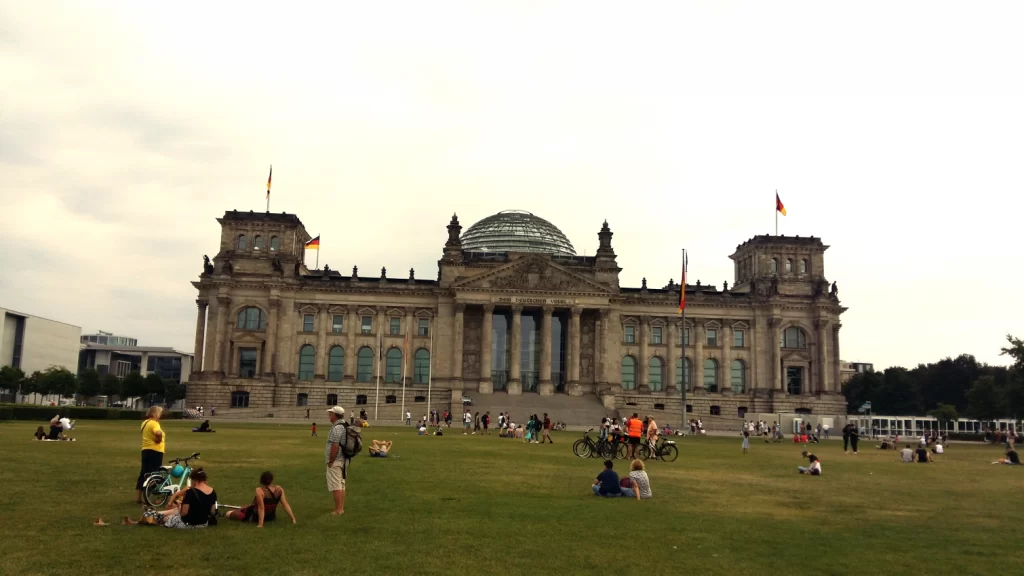
The Reichstag was in use by the parliament until 1933, when the Nazi party (NSDAP) took over. It was neglected during the Third Reich and badly damaged in World War II.
After the war, West Germany’s parliament was moved to Bonn (West Germany’s capital back then) and the Reichstag building was only used sometimes for ceremonial events. In 1990, the official reunification ceremony took place here. Soon after, it was decided that the German parliament will work at the Reichstag again.
Visitors can take a guided tour of the Reichstag from the inside, listen to a plenary session (in German only), and even go up all the way to the dome and the roof of the building.
But although admission is free, you’ll need to register online on the Bundestag website first. If you want to miss the crowds, consider visiting this place on a weekday.
There’s also the Käfer Dachgarten Restaurant at the roof, and the food is supposed to be amazing (reservations are required). The lawn area in front of the Reichstag is popular for having a picnic, spending time with loved ones, and soaking up the sun!
Tiergarten Park
Address: Strasse des 17. Juni, 10785 Berlin, Germany
Tiergarten Park is a perfect spot if you need a break from the hustle and bustle of the city. Founded in 1527, it was originally intended to be a private hunting area for Berlin’s ruling class. But since 1740, it’s been open to the public.
Tiergarten Park is Berlin’s largest park (it covers 210 hectares) and a popular spot for outdoor activities (e.g. BBQing, cycling, walking, relaxing, or playing football) with Berliners and tourists alike.

Take the kids to one of the playgrounds, then refuel at the Café am Neuen See or a beer garden, and visit the Siegessäule (Victory Column) with its viewing platform so you get to see Tiergarten Park and the rest of Berlin!
If you like German literature or classical music, don’t miss the Goethe Monument, Lessing Monument, Beethoven-Haydn-Mozart Monument, and Richard Wagner Monument.
Memorials inside and close to Tiergarten Park
I highly recommend visiting the many memorials inside or close to Tiergarten Park. They were built to honour minority groups murdered under National Socialism.
For example, the Memorial to Persecuted Homosexuals under National Socialism, a concrete cuboid first opened in 2008, wants to “set a constant sign against intolerance, hostility and exclusion towards gays and lesbians”, as per the Stiftung Denkmal. You can also watch a short movie of a same sex love scene by looking through the black window of the cuboid.
The Memorial to the Sinti and Roma of Europe, Soviet War Memorial, and the Memorial and Information Site for the Victims of the “Euthanasia” Murders are worth a visit as well.



From left to right: The Memorial to Persecuted Homosexuals under National Socialism, entrance to Sinti and Roma Monument with candles, and the open-air exhibition on the Memorial and Information Point for the Victims of National Socialist »Euthanasia« Killings. All photos by Marko Priske © Stiftung Denkmal.
East Side Gallery
Address: Mühlenstraße 3-100, 10243 Berlin, Germany
East Side Gallery is my favourite place to visit in Berlin! It’s a remaining section of the Berlin Wall, and is the longest open air art gallery in the world, at 1,316 meters (4,317 ft). I couldn’t get enough of the vibrant colours of these murals and the meaningful messages!
You can find it in Berlin-Friedrichshain right next to the banks of the Spree river. Soon after the Berlin Wall fell in November 1989, 118 artists from 21 countries started painting the East Side Gallery. It opened on September 28, 1990, with 106 murals to admire.



Impressive artistic murals at East Side Gallery. The sentence on the right one translates to “You learnt what freedom means, so never, ever forget this”.
Since the East Side Gallery is outside, it had to be restored and repainted since its initial opening. This was last done in 2009, when 87 artists participated in order to restore 100 paintings.
Tours of this unique attraction (in German, English, or French) can be arranged with the Artist Initiative East Side Gallery e.V. online. You’ll learn about the history, restoration, and the artists involved with the East Side Gallery. Tours take 60 to 90 minutes. Please find more details here.
Alexanderplatz
Alexanderplatz is Germany’s largest public square. Its nickname is “Alex” and it’s in Berlin-Mitte, only 10 minutes from Berlin’s main train station. This spot was named after Tsar Alexander I of Russia, who visited Berlin in 1805.
Street fights during the March Revolution of 1848 and peaceful protests occurred here just before the Berlin Wall fell for good. Besides, a scene in “The Bourne Supremacy” (2004) was filmed at the Weltzeituhr (World Clock), one of the main attractions of Alexanderplatz. It was first installed in 1969 and shows the current time in many big cities of the world.



The Weltzeituhr from different sides.
Alexanderplatz also has many shops, restaurants, movie theatres, and hotels. It’s busy with pedestrians 24/7, and there’s very limited parking, so I recommend going there via public transit.
There are many other attractions within walking distance from Alexanderplatz, including the popular Museum Island, Berlin Cathedral, and the Nikolaiviertel (Berlin’s historic neighbourhood).
Berliner Fernsehturm
Address: Panoramastraße 1A, 10178 Berlin, Germany
Another popular attraction nearby is the Fernsehturm (TV Tower), opened in 1969. According to visitBerlin, it’s Berlin’s “most visible landmark”. Also, at 368 m (1,207 ft) high, it’s Europe’s highest building open to the public. More than one million people visit this attraction every year.
Don’t miss its famous viewing platform and enjoy a 360-degree view of Berlin and beyond! Tickets can be bought online and start at 22.50 EUR for adults. You can also have drinks at the Sphere Bar or a tasty meal at Sphere Restaurant, and buy souvenirs at the Gift Shop.

Unfortunately, the TV Tower has very limited access for visitors in wheelchairs or who have limited mobility. When its construction was planned in the 1960s, society wasn’t as open-minded about accessibility concerns as it is today, so physically handicapped visitors weren’t considered in evacuation plans.
The TV Tower is open daily from 9 am to 11 pm from March to October and from 10 am to 10 pm from November to February.
Memorial to the Murdered Jews of Europe
Address: Cora-Berliner-Straße 1, 10117 Berlin, Germany
Memorial to the Murdered Jews of Europe (Holocaust Memorial) is a memorial that remembers the six million Jews murdered during the Third Reich. It is managed by the Stiftung Denkmal der ermordeten Juden Europas (Foundation Memorial of the Murdered Jews of Europe).
Opened in 2005, this place covers 19,000 sq meters (4.69 acres), and 2,711 concrete slabs (stelae) of various heights are standing here. The Memorial is open 24/7 and you can enter from all four sides. As per visitBerlin, it’s “a place of contemplation, a place of remembrance and warning”.

The Information Centre under the Field of Stelae
The exhibition in the Information Centre under the Field of Stelae has several themed rooms about some victims and their stories. It’s separated into the Room of Dimensions, the Room of Families, the Room of Names, the Room of Sites, and more.
Here you can look at journal entries, farewell letters, photos, personal documents, and listen to the names and short biographies of some victims.
Moreover, this exhibition displays historic film and photo footage of the places where the killings occurred. At the end, you can listen to interviews with holocaust survivors. Audio guides are available for rent and group tours can be booked as well.


Room of Families (left) and Room of Dimensions (right). Both photos by Marko Priske, © Stiftung Denkmal.
Almost half a million people visit these memorial grounds each year, and the opening hours of the exhibit are 10 am to 6 pm (Tuesday-Sunday). Admission is free and tickets can be booked online. Donations are always appreciated.
The Berlin Wall Memorial
Address: Bernauer Str. 111, 13355 Berlin, Germany
The Berlin Wall Memorial is a historic site at Bernauer Strasse, opened in 1998. This is where the border strip of the Berlin Wall separated East and West Berlin.
This street was all over the news in August 1961, when many East Berliners jumped or climbed out of their apartment windows at the last minute to escape to the West Berlin side. Some of them succeeded, while many others did not.
Today, this memorial site intends to commemorate the 140 victims of the Berlin Wall. There are also a large outdoor exhibit that covers historic audio and photo material, a Visitor Center, and Observation Tower.
But the most impressive part is the 70-metre (229 ft) stretch of high rusty metal bars, which stands at the former location of the Berlin Wall. Public tours and group tours can be booked as well.

Across the street, you find the Visitor Center and Documentation Center, and the latter shows a permanent exhibit about the history of the wall. There are also stations with historic audio broadcasts from East and West Berlin, as well as a digital archive with original documents.
The Documentation Center and outdoor exhibits are accessible for visitors in wheelchairs or with limited mobility as well.
The Chapel of Reconciliation, formerly known as the Church of Reconciliation was destroyed by the GDR government in 1985 and is at this memorial site, too. A memorial service for the victims occurs three times a week. Also, don’t miss the Window of Memorial, which tries to keep the victims of the Berlin Wall alive by showing their photos.
The Documentation Centre and the Visitor Centre are open from Tuesday to Sunday from 10 am to 6 pm and admission is free. The outdoor exhibition in the memorial area on Bernauer Strasse is open daily from 8 am to 10 pm.



From left to right: Border crossings and course of the Wall map, partial outdoor exhibit, and flowers to commemorate the victims.
The Mall of Berlin
Address: Leipziger Platz 12, 10117 Berlin, Germany
Berlin also has lots of great shopping spots, such as the Mall of Berlin right in the heart of the city. It’s Berlin’s second largest shopping center, with four floors, and has around 300 shops and a large food court!
You can find many international/European chain stores here, like H&M, Zara, Douglas (perfumery), C&A (clothing store), Claire’s, Pandora, The Body Shop, and Saturn (electronics store), but also souvenir shops.
The building has an impressive glass roof, and right next door, you can find more shopping opportunities at Potsdamer Platz, as well as theatres, cinemas, and restaurants.

Buy the Berlin Welcome Card
If you’re in Berlin for at least two days and like to save cash, I recommend buying the Berlin Welcome Card. It allows you free travel on public transit (buses, trains, and streetcars), up to 50% off at many attractions and sights, and three children up to 14 years can join one adult for free.
The pass can be bought online, and prices start at 26 EUR for Berlin and its city limits, and 31 EUR if you’d like the fare to nearby cities (like Potsdam) and Berlin Brandenburg Airport to be included.
There’s also the Berlin Welcome Card all inclusive, which starts at 99 EUR for 48 hours (for Berlin and Potsdam) and includes free entry to more than 30 Berlin attractions.
Whew, what a busy day looking at Berlin’s attractions! But there are many more things to see and do, which of course, you can’t cover in such a short time. So I recommend checking out The 18 Best Things To Do in Berlin by Nomadic Matt.
Where to Stay in Berlin
Whether you’re looking for budget, mid-range, or luxury accommodation, Berlin has a great selection of places to stay!
I stayed at the 36 ROOMS Hostel (Spreewaldplatz 8, 10999 Berlin, Germany) about 25 minutes from the main train station. This hostel was built in 1878 and is a traditional townhouse (called Altbau in German). It has four floors, high ceilings, and an easy going vibe.
There’s free wifi, lockers, and luggage storage, a garden area, and no curfew! Guests can choose between private and dorm rooms (mixed and women only).
A swimming pool, night clubs, bars, grocery stores, and restaurants are nearby, too. I booked a single room, which was rather small, but had everything I needed, and it was quiet at night.
The staff was very accommodating as well, but sometimes, the bathrooms could have been cleaner… But to be honest, the room was pretty cheap, and I’m not too fussy, so it worked for me 🙂 Unfortunately, there’s no breakfast, but you can choose between tons of restaurants with breakfast options close to the hostel.


Where to Eat & Drink in Berlin
Of course, Berlin also has a huge selection of restaurants and cafés to choose from!
I had dinner at Dean & David (Mercedes Platz 1, 10243 Berlin, Germany) a German restaurant chain. Their menu consists of salads, wraps, Buddha bowls, sandwiches, soups, curries (all either with meat or vegan/vegetarian), juices, and smoothies.
I tried their Vegan Falafel Bowl and Super Green Matcha Smoothie, so yummy! At the Mercedesplatz location, you can sit inside or outside and the service was great as well.

Van Long, a Vietnamese restaurant inside the Mall of Berlin’s food court, is a great lunch spot! You can choose between Thai and Vietnamese dishes with meat and there’s an extra menu for veggie dishes as well. I had their Mango Lassi and Tofu Summer Rolls, and they were a great pick-me-up after walking around Berlin for a while!
For breakfast, I headed to the Ramones Museum, Bar & Café in Berlin-Kreuzberg, where you can order tons of awesome veggie options! I had the Blitzkrieg Bop breakfast and a bottle of Club-Mate, a non-alcoholic caffeine drink often found in Eastern Germany.
I wrote a separate blog post about my visit to the awesome Ramones Museum as well.
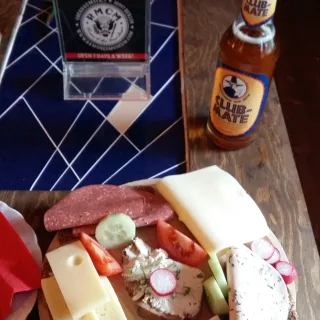
As you can see, Berlin is a great spot for vegans or vegetarians! In fact, it is one of the most vegan friendly cities in Germany, with more than 800 restaurants in and around the city.
You can also find tons of other recommendations for vegan restaurants (including vegan donuts :p), as well as a vegan-friendly hotel, and more things to see and do in Rebecca’s Berlin Vegan Guide.
How to Get to and Around Berlin
Like many other big cities in Europe, Berlin has a great public transit system. Tons of regional and long-distance trains (EC, ICE, and IC) managed by the Deutsche Bahn and FlixTrain go to Berlin many times a day, same as buses, such as FlixBus.
Within the city limits and suburbs you can hop on the S-Bahn (suburban trains), U-Bahn (metro), buses, Hop On/Hop Off buses, and the iconic yellow streetcars! Day tickets and 7-day tickets for public transit in and around Berlin are available as well.

Thanks to the good public transit system, it’s not necessary to rent a car in Berlin, especially because traffic can be insane during rush hour!
It’s also popular to explore Berlin by bicycle and I found that the downtown area was very walkable. There are tons of signs, which is very helpful! But if you’d like to visit places away from this area, I recommend biking or taking public transit.
The nearest airport is Berlin Brandenburg Airport, which opened in October 2020 (after 15 years of construction!). It’s a 35 to 40-minute train ride to Berlin Hauptbahnhof, the city’s main train station.
(Airport) buses to Berlin and nearby cities (like Potsdam), as well as private transfers and taxis are available as well. Many flights from domestic and international destinations start and land here daily.
Well, that’s a wrap on How to Spend 24 Hours in Berlin 🙂 If you have more tips on Berlin, let me know in the comments! Vielen Dank 😀
Traveling around Germany for a while? Then check out these posts:
The Ultimate Travel Guide to Bamberg, Germany
One Day in Heidelberg, Germany Itinerary: The Best Things to Do
- 9 REASONS TO VISIT LEIPZIG, GERMANY FOR A DAY - April 7, 2025
- ONE DAY IN ANCONA, ITALY: THE 6 BEST THINGS TO DO IN 2025 - February 28, 2025
- THE ULTIMATE SOUTH COAST OF ICELANDITINERARY: THE PERFECT DAY TRIP FROM REYKJAVIK - February 1, 2025


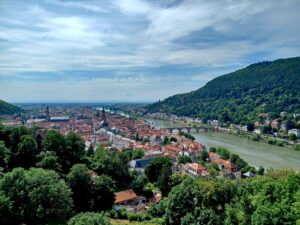
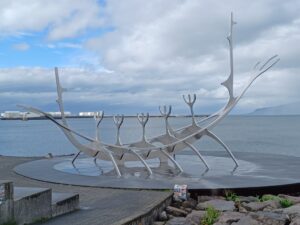


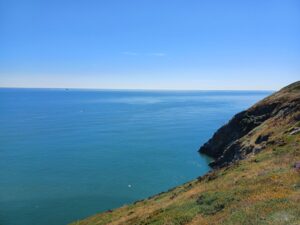
Leave a Reply